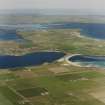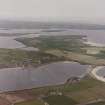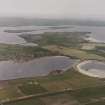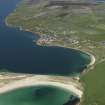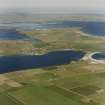Churchill Barrier No. 4, Burray To South Ronaldsay
Causeway (20th Century)
Site Name Churchill Barrier No. 4, Burray To South Ronaldsay
Classification Causeway (20th Century)
Alternative Name(s) Scapa Flow; Churchill Causeway; Water Sound
Canmore ID 112590
Site Number ND49NE 17
NGR ND 4785 9518
NGR Description ND 4802 9543 to ND 4770 9495
Datum OSGB36 - NGR
Permalink http://canmore.org.uk/site/112590
- Council Orkney Islands
- Parish South Ronaldsay
- Former Region Orkney Islands Area
- Former District Orkney
- Former County Orkney
ND49NE 17 4785 9518 (ND 4802 9543 to ND 4770 9495)
See also:
ND49NW 2 ND 4412 9670 to ND 4452 9641 Hunda Reef Barrier
HY40SE 25 HY 4840 0126 to HY 4848 0069 Churchill Barrier No. 1, Mainland to Lamb Holm (Kirk Sound)
ND49NE 15 ND 4822 9999 to ND 4785 9952 Churchill Barrier No. 2, Lamb Holm to Glimps Holm (Holm Sound)
ND49NE 16 ND 4730 9870 to ND 4744 9833 Churchill Barrier No. 3, Glimps Holm to Burray (Weddel Sound)
See also corresponding (predecessor) blockships:
ND49NE 8002 Pontos
ND49NE 8003 Unidentified
ND49NE 8004 Carron
ND49NE 8005 Collingdoc
ND49NE 8006 Clio
ND49NE 8007 Carolina Thorden
ND49NE 8008 Naja
ND49NE 8009 Lorne
ND49NE 8022 Juanita
ND49SE 8001 Gondolier
Churchill Causeway No 4 [NAT]
OS 1:10,000 map, 1985.
ND 478 952 WWI and II sea defences: Churchill barrier No 4 and blockships (Carron, Naja, Clio, Pontos, Collingdoc).
Sponsors: Historic Scotland, Orkney Archaeological Trust
G Wilson and H Moore 1997.
This causeway carries the A961 public road across Water Sound, between Burray and South Ronaldsay. Water Sound is the most southerly of the four sounds on the E side of Scapa Flow.
Information from RCAHMS (RJCM), 10 May 2006.
Field Visit (August 1997)
Barrier # 4 joins Burray to South Ronaldsay, forming one link in the chain of artificial coastal defences which connect Orkney Mainland to the islands of Lamb Holm, Glimps Holm, Burray and South Ronaldsay. These barriers were built during WWII to block off the eastern approaches to Scapa Flow which served as the base of the British Home Fleet. The barriers were constructed by Italian prisoners of war from numerous five to ten ton concrete blocks set on rubble foundations, laid onto the sea bed. After the war, a road surface was laid over the barriers, creating a causeway which forms part of the A961 road between St. Mary's Holm (Mainland) and St. Margaret's Hope (South Ronaldsay).
Moore and Wilson, 1997
Coastal Zone Assessment Survey
Watching Brief (8 August 2013 - 9 October 2013)
A watching brief undertaken on and at either end of The Churchill Barriers (Barriers 1, 2 and 4), and at West Greaves, Orkney as part of a Scottish Water pipe replacement and improvement scheme. 16 small trenches were monitored between July and October 2013. No features of archaeological interest were uncovered.
Information from L Somerville - Orkney Research Centre for Archaeology (ORCA).
OASIS ID: orkneyre1-166213
Desk Based Assessment (2013)
Historical photographs and maps demonstrate that all the blockships positioned at Churchill Barrier 4 are covered in sand. The only vessel still exposed above the sand is the top of the bridge of the SS Collindoc (ND49NE 8005), which is several hundred metres inland. This coverage is the result of coastal accretion exacerbated by the construction of the Churchill Barriers. Historical photographs show the remains before the sedimentation documenting the extent of the coverage. These remains were not surveyed as part of the project.
Information from Annalisa Christie, Kevin Heath and Mark Littlewood (ORCA) March 2014





































